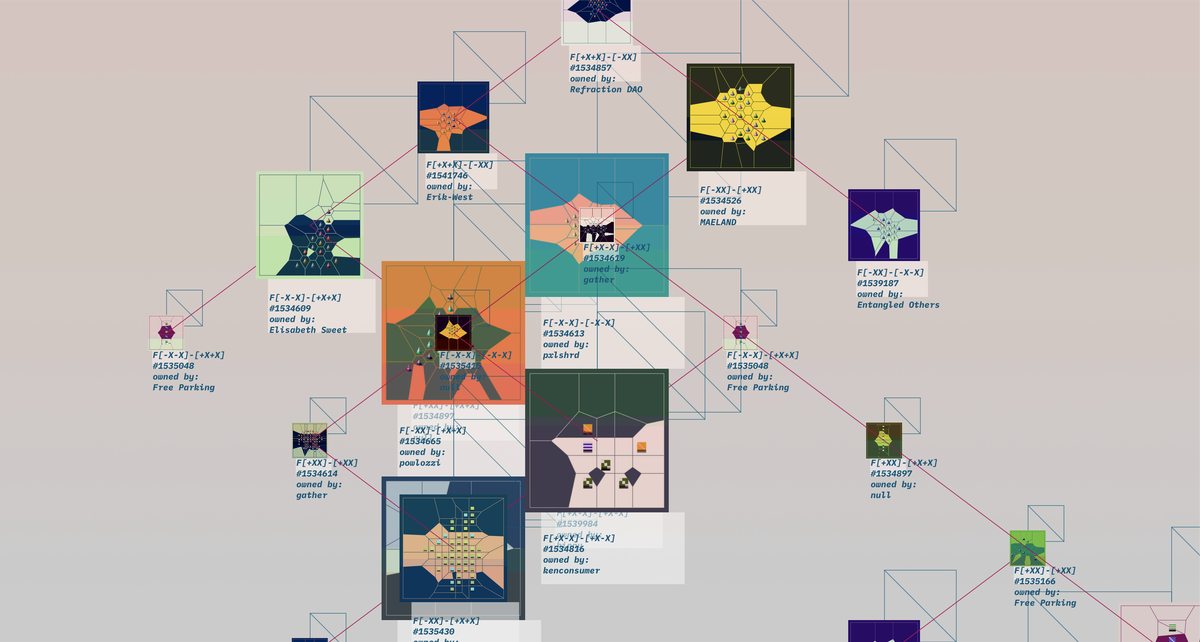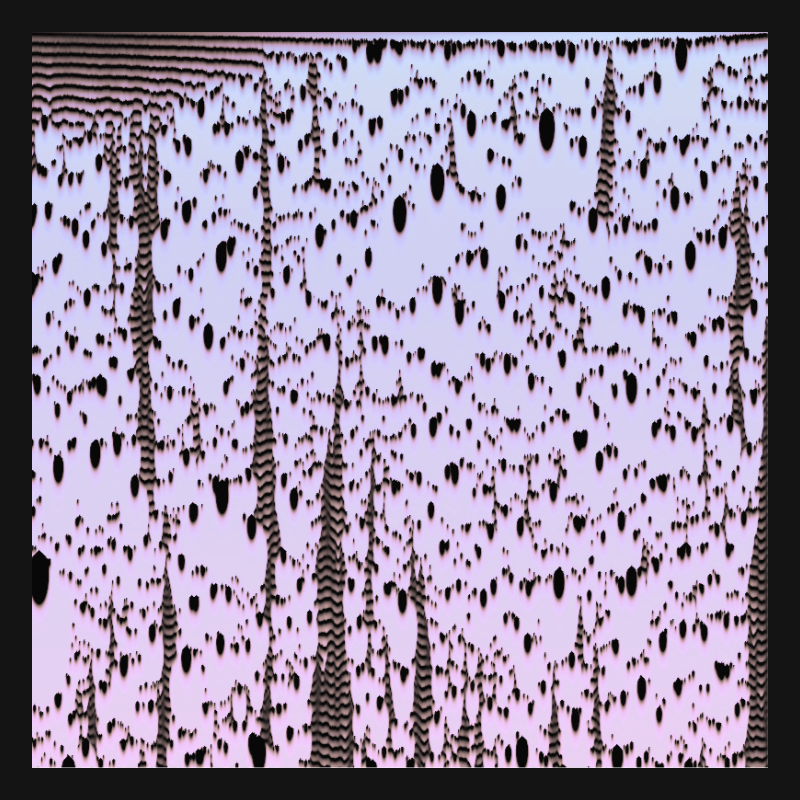
Entangled tokens
written by agoston nagy
Functional features
Generative artworks usually store their indexing data on the blockchain itself, while included scripts, images and other assets are stored within a decentralized filesystem (usually on IPFS, short for interplanetary file system). The beauty with code based art platforms is that some features of a piece are stored on-chain or as parts of the corresponding transaction parameters, derived from the smart contract of the project. This makes it possible to create unique, consistent iterations from the same codebase that the browser can compile and show accordingly when someone is viewing the artwork. Upon collecting (minting) a new iteration of the piece, a unique metadata is generated that is derived from blockchain transaction parameters: this will stay specific forever to that freshly minted instance. Nor the creators, nor the collectors know exactly how the resulting piece will turn out, they just have an overall understanding of the structure and outcomes of the algorithms involved in the artwork.
Fx-hash uses these features as parameters to create long-form generative series, which are best known for their numerous iterations (usually tens, hundreds or even thousands of possible unique variations) and their open-ended nature. Since they are code based, they can involve temporal events, chance operations, user interactions and all sort of possibilities that a web based application is capable of.
These unique features are stored in the metadata, so they can be queried and fetched from outside of the marketplace ecosystem, using available blockchain APIs, such as TZKT, or the endpoints of fx-hash GraphQL. Third party apps can load, work and even trade using these API calls properly, and there are many possibilities to build custom minting experiences for special audiences this way. Features can also help filtering large sets of collections, based on the different outcomes and characteristics which makes navigation through them much convenient.
Continuing this logic, using metadata as a functional part of an artwork can make it possible to create shared experiences between individual tokens, that can result in collaborative, commonly created / owned pieces, such as gateway tokens within different initiatives (usually DAO memberships and governance models). These social efforts can also be thought of as analogies to consensus based public interventions in physical spaces that involve collective decisions and activities in order to realize them. As a historical example, Joseph Beuys had an interesting idea to transform art into the wider fabric of society: he initiated a project that was about to plant 7000 oaks as part of Documenta 7, in 1982, to ‘raise ecological consciousness -raise it increasingly’ as he described. He deposited 7000 basalt markers outside the Fridericianum. 7000 oaks were to be planted beside the markers so that as the project advanced, the pile of stones diminished. His own words sum up the effect, ‘The planting of seven thousand oak trees is thus only a symbolic beginning. And such a symbolic beginning requires a marker… we shall never stop planting.’ He formulated a so called ‘social sculpture’, where each tree was symbolized with a rock in the public area, and when a tree has been planted, a rock was taken out from the stack, creating the slowly evolving entity that changes over time, caused by the civil participants, with a possibility to leave the process open to run ad infinitum.
After all, systems thinking, algorithmic methodology and procedural problem solving can be applied beyond coding, computers and networked infrastructures: they can be used to program and initiate social processes, interspecies decision making and ecological transformations. Within the web3 space, these complex computational strategies can be translated as transactions that operate between different circles of individuals and collective communities, where the public agora is the blockchain and the dynamically evolving artwork can be a generative token, unfolding through the co-creation of artists, audience, collectors and resonators.
Metapoetry
Blockchains are immutable data storage systems that are creating unchangeable micro-histories, emerging automatically from their very nature: each new addition is added on top of previous states and there is no way to erase or delete previous logs and additions from the network. Once a generative artwork has been minted, it will be part of a continuum in space and time, it will have its unique index, transaction id and attached features, as defined in the minting contract. Personally I find it transcendental to be able to write such micro-histories and self-documenting architectures, so I started to play with some of the poetic aspects of transaction specific metadata within one of my earlier projects, called LandWaves.
project name project name project name
I found it interesting that beyond words, special character encodings can also be stored and retrieved from there, which of course leads to ascii art, glitching language, concrete poetry, written spells and phrases that are not directly connected with the body of the visual artwork. I considered those as easter eggs, small surprises for the sharp eyed collectors who might have some interesting impressions by viewing these minor additions to the artwork.
However, I had no intention to move forward with these semantic components with LandWaves, they were left on the decorative yet philosophically engaging levels within the piece. Open ended experiments to be followed up later. Recently, upon reading about the Creative Grants of RefractionDAO, an open call for web3 based artworks and cultural projects operating on a wider level of context, I decided to continue tinkering with the conceptual mechanics of tokenized artworks: play with metadata, reframing the role of the components within the body of the series, causing changes, acting in the social domain, beyond the generative aesthetics and the visual appearance.
Programmable art and ecological interventions
I created an anonymous test release on fx-hash called L-Template, to study how to store metadata properly as functional building blocks for a collective rendering system. The mutual aspects of the concept were already involved in the process: anonymity, shared vibes and common values with a DAO, involving many likeminded and talented people from around the world. The first tests of experimentation were already out there on the chain, as free templates. We created the test dataset together with the fx-hash community, so I could start playing and testing the idea out there, in the wild. The vision was to turn the act of art creation and collection with all its fun parts and network effects into a system, that affects our living and physical environment with a positive outcome: to help conservation, rewilding and planetary healing in the form of automated donation to nonprofit organizations who are involved within such activities.
project name project name project name
In 2021, I had very positive experience with the Processing community, where I donated all of the primary revenues of Mira, one of my dedicated, code based pieces to the Processing foundation as part of the Processing Community Day. Apart of giving back to the initiative for enabling my career as a creative artist, this event also brought me more visibility as a creator, so the whole story turned out to be such a win-win situation. Based on this experience, I decided to extend the concept of a programmable medium from the code and execution level to the social and ecological level. Since blockchains are completely transparent and transactions can be programmed into blockchain based artworks, why not split and forward a significant portion of the income of the piece over to environmental conservation funds and create effects outside of the networked infrastructure?
L-Systems
I usually work with simple algorithms for creating shapes, lines, sounds and abstract micro-worlds, so I went on with the idea to use L-Systems as the basic generators within this experiment. What are those? In 1968, Hungarian botanist Aristid Lindenmayer developed a grammar-based system to model the growth patterns of plants. Lindenmayer systems — or L-systems for short — were originally conceived as a mathematical theory of plant development. On one side, a central concept of L-systems is that of rewriting: it is a technique for defining complex objects by successively replacing parts of a simple initial object using a set of rewriting rules. On the other side, a fundamental component of fractal geometry is recursion, which is the repeated application of a rule to successive results. Therefore, the rewriting concept of L-systems is an efficient mechanism to apply recursion in order to achieve complex fractals. They can be represented as short strings, which is ideal to be stored within the metadata of the token. They also lead to emergent and complex systems easily, which is why they are used in many contexts from biological research to music composition and game level design.
With L-template, first I created a token that can be rendered entirely from the generated metadata using GraphQL. It is possible to make custom renderings and collective compositions from the individual iterations by rearranging, sorting, or animating them. Since owners, transfers, timestamps and other parameters can also be queried from the artifacts, further explorations with visualizing token dynamics, trading patterns, community efforts and other components seem very promising.
Terrain
Terrain turned out to be an audiovisual experiment halfway between a self-modifying game board and a musical interface. The unfolding algorithm is stuck infinitely in the process of filling its surroundings. However, infinite growth within a constrained environment that has limited resources is impossible, so the piece confronts us with our everyday anomalies of productivity versus maintainability, hyper-capitalist infrastructures versus shared commons, individualism versus collectivism, etc. The music is based on the steps of this never-ending game mechanic, creating a slow, continuously changing ambient soundscape. As with most of my previous pieces, the audio engine consists of a few generators (sine wave and triangle wave oscillators), directing the signals over band pass filters and reverberators before manifesting into physical existence through the membranes of your speakers. The initial structure of the board is generated with the simple L-System, encoded in the token’s metadata. This is then combined with a tessellation algorithm to form fragments of a terrain. The result is an area of regular shapes and contours, filled with vivid and contrasting colors that resemble navigational charts, philosophical games and digital cartography.
project name project name project name
Metabolism
Originally I started building a small microsite for the project, to communicate the progress to our community, making the steps of the development as transparent as possible. While discussing minor details over Discord, this site also provided some general concepts for the Terrain project for a wider community beyond the DAO, since my intention was to introduce a socially transformative element (donation) that should be realized as a collective (through voting). The donation process was based on a community wide voting session using Snapshot, a voting tool based on the IPFS decentralized storage system, used by many crypto projects to poll their user bases. It is worth to mention here, that all the Creative Grant projects were validated by another, community wide voting session from before.
As of now, the microsite has been transformed into a dashboard, that became part of the artwork itself: it displays all the minted tokens among some visual representations of their metadata, names of the collectors and the actual state of the fund being raised. A collective, interactive landscape is being created from these pieces and building blocks, where the custom, in-browser environment can replicate the audiovisual structure of the minted tokens and place them into one scene. This space can be turned into a shared experience: an x-ray, a quantum-symmetric quasi-crystal, a self-illuminating skeleton, a subliminal kid that visualizes the metabolism of the long-form body of a collective artwork that is manifesting itself into an unpredictable scope of space-time trajectory.


